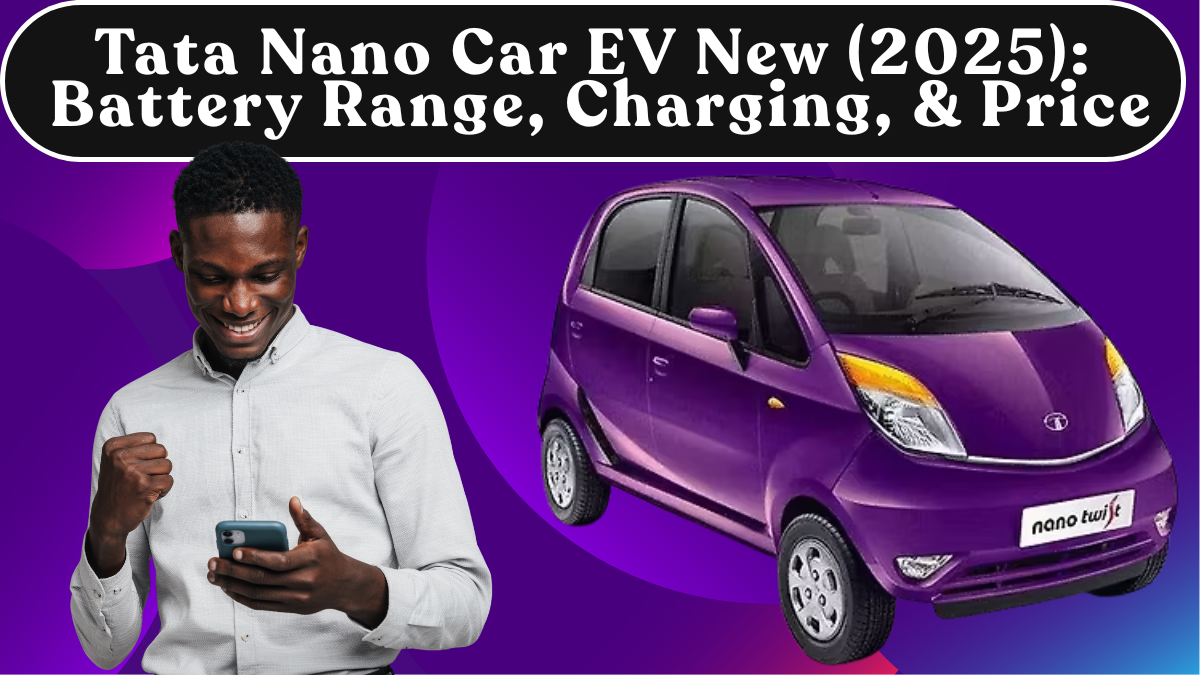The iconic Tata Nano is back in the spotlight — this time as an electric car (EV) ready to redefine affordability in India’s fast-growing EV segment. Tata Motors has been teasing its Nano EV revival project since early 2025, and recent sightings have confirmed that the “people’s car” is being reinvented for the electric era. Compact, efficient, and designed for the urban Indian commuter, the Tata Nano EV 2025 could be one of the most accessible electric four-wheelers ever produced in the country.
As the Indian EV market heats up with rivals like MG Comet, Citroen eC3, and Maruti’s upcoming EVX, Tata’s move to reintroduce the Nano brand electrified could mark a new chapter in the small-car segment.

Design and Exterior Updates
The new Tata Nano EV retains the core design philosophy of the original Nano — compact dimensions and simple, functional aesthetics — but receives major design updates to suit the electric transition. Expect a smoother front fascia with closed-grille styling, slim LED DRLs, and modern projector headlamps.
The bumper design is more aerodynamic, and subtle blue accents along the body highlight its EV identity. The side profile remains tall-boy, maximizing interior space in a small footprint. Redesigned 14-inch aero wheels enhance both looks and efficiency.
The charging port is integrated neatly on the front fender, and the rear features LED tail lamps connected by a sleek light bar — a modern touch over the older Nano design. The Nano EV will be offered in vibrant two-tone colors, including Electric Blue, Silver Grey, and Pearl White.
Despite being small, the new Nano EV aims to look trendy and futuristic while staying unmistakably Nano.
Interior and Cabin Features
Inside, the Tata Nano EV 2025 focuses on practicality with a youthful, tech-forward appeal. The cabin uses a dual-tone theme with a centrally mounted infotainment screen — a signature Nano trait — now upgraded to a 7-inch touchscreen display supporting Android Auto and Apple CarPlay.
The digital instrument cluster provides real-time data on battery status, range, and efficiency. Tata has also added touch-sensitive climate controls, a flat-bottom steering wheel, and rotary gear selector knob, similar to those seen in the Tiago EV.
Despite its compact size, the Nano EV maintains a surprisingly spacious cabin thanks to its tall-boy structure. It comfortably accommodates four passengers with decent legroom and improved seat cushioning. The seats use fabric upholstery made from recycled materials, reflecting Tata’s sustainability goals.
Storage spaces are cleverly distributed across the cabin, and the boot offers around 120–150 liters of capacity — enough for daily groceries or small luggage.
Additional features include:
-
Power windows for front and rear
-
Keyless entry and start/stop button
-
USB-C charging ports
-
Rear parking camera
-
Bluetooth-enabled audio system
-
Automatic headlamps and rain-sensing wipers
Battery, Range & Charging Details
Under the hood, the Tata Nano EV is expected to use the Ziptron-based technology shared with the Tiago EV and Punch EV. It will likely feature a 19–21 kWh lithium-ion battery pack, delivering a real-world range of 200–240 km on a single charge.
In standard conditions, the ARAI-certified range could touch 270 km, putting it ahead of many micro EV competitors.
Charging options include:
-
AC home charger (3.3 kW): Full charge in approx. 6.5 hours
-
Fast DC charger (7.2 kW): 10–80% in 55 minutes
Tata will also offer portable charging solutions for apartment users and public charging compatibility with Tata Power EV network stations across India.
The Nano EV will likely feature regenerative braking, drive mode selector (Eco/City), and Hill-Hold Assist for smoother urban driving.
Performance and Drive Feel
While the Nano EV won’t aim for sporty performance, it’s expected to be a capable city commuter. The electric motor will deliver around 55 PS of peak power and 110 Nm torque, enough for brisk urban driving and occasional highway runs.
Acceleration from 0–60 km/h should take about 6 seconds, with a top speed capped near 100 km/h for safety and efficiency.
The steering has been recalibrated for light city maneuverability, while the suspension setup (MacPherson struts front, semi-trailing arm rear) promises improved ride comfort over the original Nano. With a turning radius under 4 meters, parking and tight turns will be effortless.
Safety and Build Quality
Safety has been one of the biggest improvements in the new Nano EV. The structure now complies with Bharat NCAP norms, featuring a reinforced body shell, dual airbags, ABS with EBD, and seatbelt reminders.
Tata may also integrate rear parking sensors, high-mount stop lamp, and speed-sensitive auto door locks. A driver fatigue alert system could also make its way into higher variants.
Even though positioned as a small city EV, Tata aims to deliver peace of mind with a 5-year battery warranty and 8-year/1,60,000 km motor warranty similar to other Tata EVs.
Expected Variants and Colors
The Nano EV lineup could include two to three variants — XE, XM, and XZ+ — mirroring Tata’s standard EV structure. The top XZ+ trim may offer alloy wheels, larger infotainment screen, premium finish, and connected-car features.
Color options are expected to include:
-
Electric Blue (Signature shade)
-
Dual-tone White with Black Roof
-
Silver Metallic
-
Red Berry Gloss
Price and Launch Timeline
The Tata Nano EV is expected to launch in late 2025 or early 2026, with testing already spotted near Pune.
Tata’s goal is to make it India’s most affordable electric car, and pricing will be critical. The expected starting price is around ₹5.99 lakh (ex-showroom), going up to ₹7.49 lakh for the top trim.
This places it below the MG Comet EV (₹7.98 lakh) and near the Citroen eC3 base variant (₹11.6 lakh) — making Nano EV an unbeatable city-car proposition for cost-conscious EV buyers.
The car is likely to debut under Tata Passenger Electric Mobility (TPEM) branding and will be eligible for FAME-II and state EV subsidies, reducing the effective cost further by up to ₹80,000.
Why the Nano EV Matters for India
The Nano EV could do for electric cars what the original Nano did for petrol cars — democratize ownership. With India’s EV adoption rapidly rising and charging infrastructure expanding, an accessible small EV fits perfectly into the current market ecosystem.
For city users, the Nano EV’s compact size, low running costs (₹1.2/km), and zero tailpipe emissions make it ideal for everyday commuting. Tata’s reputation for reliability, service network, and commitment to local manufacturing add to its appeal.
It’s more than just a revival — it’s a symbol of India’s affordable electric mobility revolution.
FAQs
What is the range of the Tata Nano EV?
The Nano EV offers a real-world range of around 200–240 km, with an ARAI-certified figure close to 270 km.
How long does it take to charge?
Using a 3.3 kW home charger, it takes around 6.5 hours for a full charge. Fast-charging can charge 80% in under 55 minutes.
What is the expected price in India?
The expected price is between ₹5.99 lakh and ₹7.49 lakh (ex-showroom).
Does it support fast charging?
Yes, the Nano EV supports DC fast charging up to 7.2 kW.
When will it launch?
The official launch is expected in late 2025, with deliveries beginning in early 2026.
Click here to know more.
